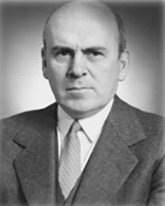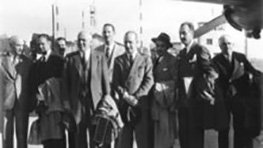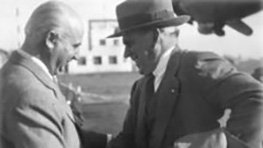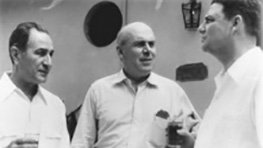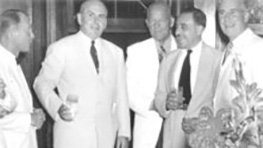2nd World Bank President, March 17, 1947 - June 30, 1949
During his tenure, the Bank started to borrow in the capital market; it defined its basic policies and operational procedures; made its first loans for reconstruction and for development; filled out its management team; and doubled its staff to 400. Most importantly, it settled the issue of the division of responsibilities between the president and the board of executive directors - an issue that had plagued the presidency of Eugene Meyer
Personal History
John Jay McCloy was born in 1895 in Philadelphia. He attended Harvard University (interrupted by a two year stint in the army), and practiced law in New York and Europe for the next twenty years. McCloy was a conservative Republican, but affiliated with the internationalist wing of the party, which was more interested in foreign affairs and focused primarily on the U.S. role in the international order.
Immediately preceding the U.S. entry into World War II, McCloy moved to Washington to work with Henry L. Stimson, the U.S. Secretary of War. McCloy was soon appointed Assistant Secretary of War. McCloy played a key role in mobilizing the U.S. economy for war. He was involved and participated in most of the key decisions of the war, including the development and use of the atom bomb and occupation policy in Europe and Japan. By the time McCloy came to the World Bank, he had already acquired an immense reputation as a lawyer, wartime manager, and adviser, with close ties to many of the most powerful men in the country.
In 1947 McCloy accepted President Truman's offer to be high commissioner for occupied Germany. However, he insisted that the Bank have a capable leader before he left, and suggested that his close friend and associate Eugene Black succeed him. In his pre-Bank career McCloy had been a key decision maker in the shaping of many of the country's foreign and military decisions. In fact, McCloy's time at the Bank was only a small part of an important and illustrious career in public service.
Selection as President
The Truman administration had difficulty finding a suitable successor to Eugene Meyer. The Bank at that time was viewed with skepticism, if not outright hostility, by the conservative banking and insurance communities, which regarded it as a product of liberal, financially unsound, welfare thinking. In addition, the Bank's executive directors were becoming increasingly uneasy over the fact that the Bank presidency and vice presidency had been vacant for a number of months.
McCloy was probably first approached by Eugene Meyer and Chester McLain (the Bank's general counsel), and by Eugene Black (then vice president of the Chase National Bank, and soon to become the U.S. executive director for the Bank, and then Bank president). All three urged that he insist on appropriate executive authority before accepting the position. McCloy met with the executive directors and presented a list of conditions that would have to be in place before he accepted the position. After a series of meetings, the executive directors voted to approve McCloy's nomination. Eugene Black was appointed U.S. executive director, and Robert L. Garner was appointed vice president of the Bank on the same day, March 17, 1947.
Decision on Executive Authority
Defining Loan Policies
There was some public perception of the inaction of the Bank at the time McCloy was appointed. The Bank had received a number of loan applications from European and developing countries, and McCloy's arrival gave the necessary momentum to the negotiations. Thus on May 7, 1947 - six weeks after McCloy's arrival - the Bank's first loan was made to the Credit National, a semipublic French corporation, for postwar reconstruction. This loan, the very first, deviated from what was to be the standard pattern for loans: it was not for a specific project, but rather a general purpose loan, covering almost every sphere of activity in industrial life.
The first loan helped establish some of the Bank's most important policies, including the interest rate to be charged, the security the Bank might require, and the Bank's control over the use of the funds it provided. After much discussion it was decided that the same interest rate would apply to all loans granted at any given time, because it would be difficult and inappropriate to have different conditions for different countries. It was realized that real collateral could not be obtained due to the nature of the borrowing countries' assets. Instead, the security sought by the Bank was the pledge of the member country's full faith and credit and the promise that no future creditor would take precedence in repayment over Bank loans. This was the so-called negative pledge. And finally, rigorous supervision and careful control over the disbursement of funds and the verification of their actual use for the agreed purposes became standard procedure for Bank loans.
Mobilizing Resources
He felt strongly that the views of the U.S. investor must be considered, and that the Bank must conduct its business in a manner that would be considered a sound business risk; that earning the trust of the financial community took precedence over meeting the wishes of the member governments.
McCloy knew that demonstrating the soundness of the Bank's performance would provide the best assurance for investors. Determining the creditworthiness of the Bank's borrowers was thus a primary concern. The earliest determination on creditworthiness came down to a country's behavioral characteristics, reputation, and its demonstrated willingness to settle outstanding claims. McCloy used the latter argument to persuade borrowing countries to make arrangements to settle their outstanding debts so that they would become eligible to borrow money from the Bank. Despite objections from debtor countries and the U.S. administration, McCloy was adamant, and the principle that the Bank would not lend to any country which had defaulted on its debts without at least a bona fide effort to settle became firmly established.
The Bank's first bond issue occurred early in McCloy's tenure. McCloy spent much time and effort, calling on his extensive networks of contacts in the financial community. The bonds, issued in July 1947, were heavily oversubscribed and were a complete success. The financial press commented in admiring terms on the shrewd judgment reflected in this efficient operation.
McCloy (and Black) wanted to demonstrate that the Bank was autonomous, free from political interference, and run according to sound financial and organizational principles. The establishment of the executive autonomy of the president, the emphasis that investment decisions would be made on economic rather than political grounds, and the close link between the president and the U.S. executive director were important factors in bolstering the confidence of the U.S. securities market.
From Reconstruction Loans to Development Loans
During McCloy's tenure, the Bank loaned about $650 million, the bulk of which were for postwar reconstruction in Europe. McCloy was aware that the Bank was required to distribute its lending equitably between reconstruction and development, and he faced pressure from executive directors and from developing countries to extend lending into the development field. Also some critics felt that the Bank was lending too little and too slowly.
The first development loan was made to Chile in March, 1948. By the time McCloy left, the Bank had made five development loans (Mexico electric power, Chile agricultural machinery, Chile power and irrigation, Brazil power and telephone) and five more were signed within six months of his departure.
Political and Economic Factors in the Bank's Decisions
From the outset there was much concern about the role of political considerations in the Bank's lending decisions. The discussions at Bretton Woods had dwelt on the importance of insulating the lending decisions of the Bank from politics and ideology. McCloy realized that the Bank did not operate in a political vacuum and that the line between politics and economics was not sharply delineated. His philosophy was that the Bank would not make loans to accomplish political objectives, but it could refuse to make loans where the political uncertainties were so great as to make the loan economically unsound.
However, the Bank's largest shareholder - the U.S. - held considerable influence, and political considerations were a factor in the Bank's handling of a loan application from Poland. McCloy agonized over whether to lend to a country behind the Iron Curtain, and he sought advice from Wall Street. The recommendations said that while it was important to consider how loans to Poland or Czechoslovakia could affect the credit of the Bank, it would be disastrous if McCloy were to consider the Iron Curtain an impenetrable barrier. The Bank subsequently entered into negotiations with Poland. It soon became obvious that the U.S. would not support the loan proposal. McCloy and Vice President Garner, in effect, withdrew the loan offer. Poland protested and ultimately withdrew its membership from the Bank, claiming that the Bank was favoring western governments over Eastern Europe. In this instance, the Bank's lending was clearly influenced by the international tensions between east and west.
Relations with the United Nations
The United Nations sent a letter to the Inaugural Meeting of the Bank in Savannah, proposing a cooperative agreement between the United Nations and the Bank. But the president and executive directors of the Bank agreed that the confidence of the Bank's investors depended upon the Bank's arms-length relationship with governments and political bodies in general. Any suggestion that the Bank's decisions were subject to the influence of outside interests would be detrimental. President Meyer had postponed the issue of a formal arrangement between the two institutions, saying that the Bank was in such an early stage of operations that a formal agreement was premature.
